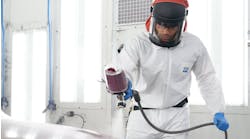Is color match included in a refinish labor amount of 0.3 for a small filler panel? It’s a simple question without a simple answer. Actually, the answer has several dimensions to consider—the most obvious being the repair situation surrounding this part. Another is the way each information provider deals with this subject.
In the most likely case, this small part is being refinished along with one or more major exterior panels. We can assume any color-match effort is spread across all those parts, as is the compensation. Occasionally, this small filler is the only part being refinished. In that case, one might question how close the color match needs to be and how much effort would actually be involved. It’s probably not as critical as a fender-to-door match. Still, 0.3 is not a great deal of compensation for all that is needed when refinishing a single part by itself.
If it’s a customer-pay job, explaining and recovering additional costs may be relatively easy. If this is for an insurance claim, you may need to bring out your best negotiating skills. Either way, the procedure pages will need to come into play. That widens the subject to color match in general. Is color match considered at all? If so, what part of the process? Is there a line between normal and excessive?
The following basic color match steps are relatively clear in theory:
- Obtain color information, code, paint chip and/or variance data.
- Order or mix paint.
- Check color against the vehicle.
- Spray-out test panel.
- Check test panel against vehicle.
- Tint paint and retest color.
- Repeat until satisfactory.
- Blend into adjacent panels.
All these steps could be done on any job, but they aren’t necessary for every job. The decision between the extremes of everything and nothing has many variables, including the color itself, paint products, equipment, painter’s skill and experience, and business decisions related to workflow.
Now how do the information providers handle this?
MOTOR'S refinish labor includes the following: Retrieve accurate color information, including paint chip. The following tasks are itemized as “Does Not Include”: color matching to adjacent panels, test spray-out panel, tinting to achieve color match and blending into adjacent panels.
ADP’s refinish labor includes the following: get paint code, order/get paint, initial color tint and spray test panel. “Not-Included” tasks include spray additional test panel, tint primer or clear and blending into adjacent panels.
Mitchell’s refinish labor includes the following: mix materials and adjust spray equipment without identifying specific steps for obtaining proper color. “Not-Included” tasks include the following: blending into adjacent panel and/or panels, or nearest break point and color match or tinting.
Each information provider references it a little bit differently, so there is no simple or general rule when it comes to compensation for color-match efforts. Each information provider acknowledges some initial effort for paying attention to color, and that would be reflected in their refinish labor amount. The line between expected effort and excessive effort is different among them, although they each leave a basis for negotiations.
Blending could still be needed on many jobs to hide any remaining color variation. Blending is not included by any information provider and has automatic calculations by each information provider when selected. However, a good color match doesn’t always go easy and the effort, or steps involved, can quickly escalate into tinting, additional test panels and more. Some jobs can turn out quite problematic and that is difficult to predict at estimate time. Maybe with the right experience, trouble could be predicted on some jobs, but most are surprises, such as working with a new color, an unknown color variance or poor color coverage.
Being aware of this and your information provider’s procedures is the first step in negotiating fair compensation when these situations arise. Requesting additional labor for color match on every job is probably unreasonable. Requesting additional labor for color match on no job is equally unreasonable. There is a middle ground somewhere, and good, honest negotiations are the only way to find it. Negotiate that lone 0.3 filler panel to a fair amount for all involved: the vehicle, its owner, the insurer and yourself.
“Every problem contains within itself the seeds of its own solution.”
– Stanley Arnold




